Closet Cleanout 101: A Step-by-Step Guide to Getting Your Wardrobe in Order
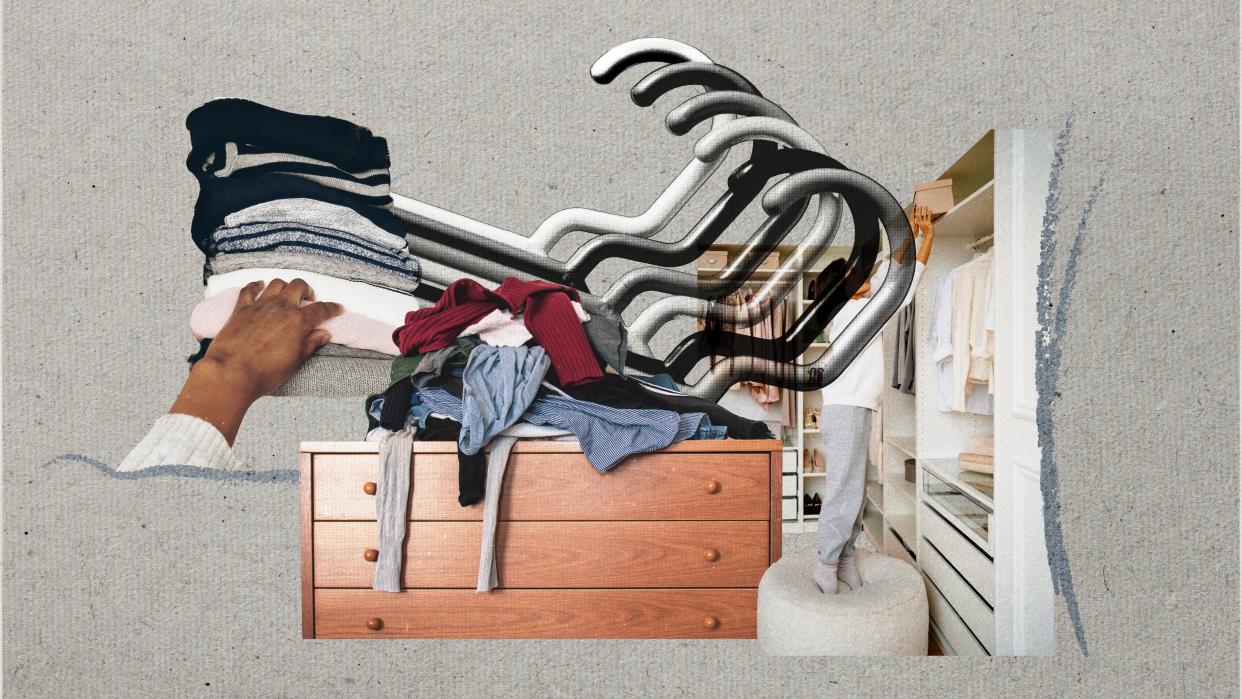
Illustration: Julia Abbonizio/Getty Images
Professional organizer Aaron Traub has it right when he says that yesterday was the best day to do a closet cleanout, and today is the second-best day. “Understandably, a closet cleanout and refresh can feel daunting, but it doesn’t have to be,” adds Traub, owner and lead organizer of My Professional Organizer Dallas. Given that we all access our closets every day, Traub feels the space should offer an opportunity for “routine, and not the feeling of overwhelm.” Ann Lightfoot, a Montclair, New Jersey–based professional organizer and cofounder of Done & Done Home, explains that the end result of a full closet cleanout is worth the chore. “A couple of hours spent sorting things now will mean an entire season of stress-free living,” she says. Whether you’re getting into some spring cleaning or transitioning into a new season’s wardrobe, there’s no time like the present to manage the disorder in your closet. Read on for advice from organizing pros on how to ace your closet cleanout.
How to clean out your closet in 6 steps
You may conceive of a closet cleanout session as an all-day (or even multiday, gasp) affair, but it doesn’t have to be: “In truth, you don’t need to dedicate continuous time to organizing your closet,” says Sarit Weiss, founder and lead organizer at Neat & Orderly, a professional organizing company based in New York City. Especially for those who are strapped for time or get easily overwhelmed by organizing, Weiss recommends setting aside an hour or so per session (every day for a week, on Saturdays for a month, etc.) to tackle sections within your closet, such as the floor area, or the hanging rod, or the shelves.
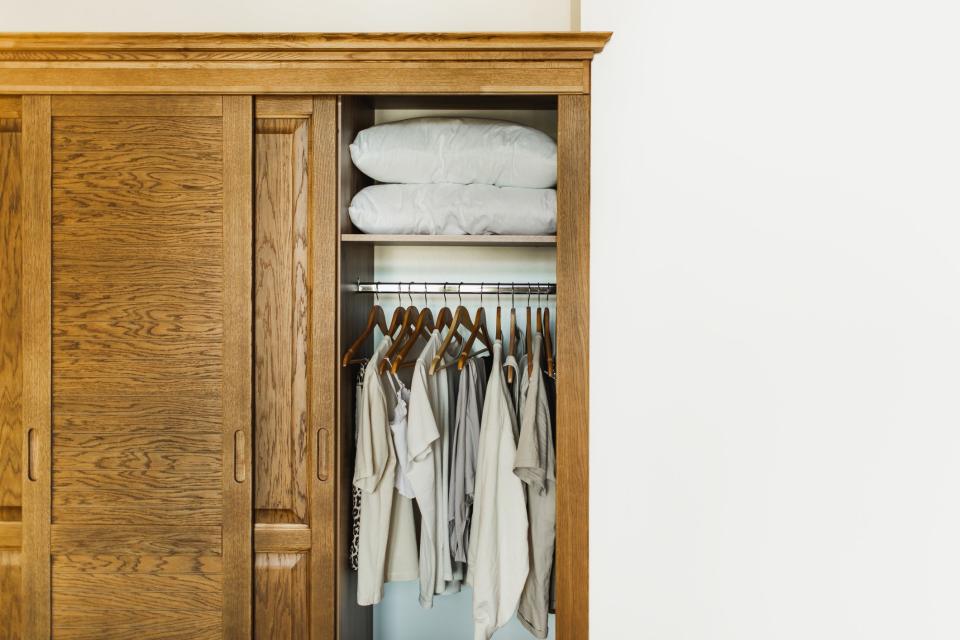
Brown wooden wardrobe with clothes and pillows inside.
Expanding on that sentiment, Traub stresses that every closet is different and the amount of time necessarily dedicated toward closet cleanout will vary from one person’s space to another. “However, if you start small and stay consistent, the process of purging items in your closet can be a freeing and positive experience,” he says. What’s more, Weiss believes this strategy can also help you feel more accomplished as you go on organizing your closet.
As for the seemingly elusive outcomes of, say, streamlining your capsule wardrobe or increasing your free closet space dramatically? It’s certainly possible that improving your closet organization can impact your day-to-day in a significant way. “Releasing the excess clutter can transform your routine and peace of mind,” says Traub.
Below, a step-by-step guide on closet cleanout following the insights of Weiss, Traub and Lightfoot. (Note: The following guidelines hold true for bedroom wardrobe closets and coat closets. For pantries, consult our guide for elegant and practical pantry organization ideas.)
Step 1: Commit to the process
Traub explains that the first step to any closet cleanout is always simply making the definitive pledge to do it. “Commit to decluttering and cleaning out your closet once and for all,” he says. To hold yourself accountable, you may find it helpful to block out a digital calendar hold on designated days in order to manage your closet organization, or add “closet cleanout” to your daily pen-and-paper to-do list.
And if you’ve been procrastinating on the task for months (…or years), know that you’re not alone. After working in hundreds of women’s closets over the years, Lightfoot would say that almost everyone struggles with how to manage their wardrobes. “The fact that money, how we feel about our current shapes, and memory all come into play means it’s hard to pare down our wardrobes for very real reasons,” she says. Lightfoot poses a strong case for conquering your fears and handling the cleanout sooner rather than later: “Many of our clients have told us they’ve gotten better with practice,” she says. There’s only one way to confirm that for yourself.
Step 2: Get a lay of the land
“You will want to get a better understanding of your space to fit the organizing products you will purchase,” she says, noting that it’s a good idea to use a measuring tape to get the dimensions of each shelf or storage area.
Once you’ve got the measurements, Weiss says to buy organizing products to fit those dimensions. Try the Container Store, Pottery Barn, Crate & Barrel, Amazon, Target or whatever local outfitter you prefer (more on our top closet organization products below). A hidden bonus to buying your organizational vessels up front? It can help you feel excited and visualize the amazing transformation your closet will have, says Weiss.
Step 3: Take everything out of your closet
You knew this one was coming. If you’re opting to carve out an afternoon or a weekend for cleaning out your entire closet as opposed to a bit-by-bit approach, everything must be removed from the space first for the most hassle-free and efficient experience.
Lightfoot calls pulling everything out of your closet “an essential step” to ensure that you’re not simply passing by items that you’re less inclined to deal with. “It’s much easier to defer a decision about an article of clothing if you don’t have to physically hold it, look at it, and try it on,” she says.
Step 4: Sort like items together
“Make categories and then subcategories of everything. For example, pants, then jeans, then color of jeans, then style of jeans,” says Lightfoot. She explains that this strategy will “make it easier to make decisions about what to keep and what to let go of, because the ‘duplicates,’ ‘always wear’ and ‘never wear’ items will become obvious.”
During this closet decluttering step, Traub says to get two boxes (or large bags) ready nearby, one labeled “donations” and the other “trash.” If you’re hoping to sell things, you could have a third box on hand labeled “sell.”
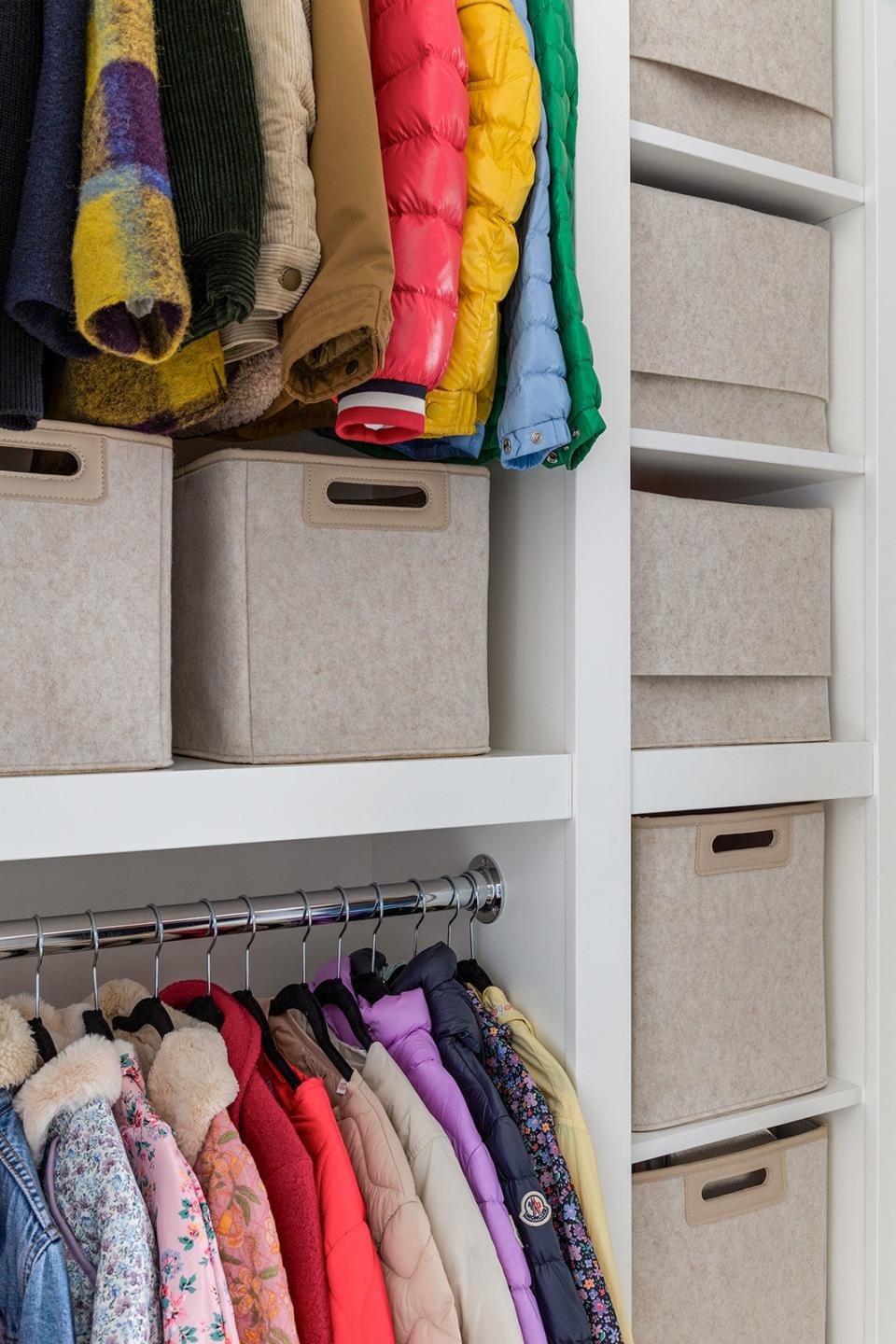
25B
Step 5: Try everything on
We’ll let Lightfoot deliver this bummer: “We know people hate to hear this, and we know it can take up a lot of time, but if you want a functional closet, it has to be full of the things you love and that fit.” Note: Out-of-season clothing and things that don’t currently fit but are within a size or two should be placed on a high shelf or in a bin that’s tucked away out of your working wardrobe, says Lightfoot.
Regarding the order in which you’ll tackle the categories of similar items you created in step four, Traub advises starting with an easier option first to help build momentum. “We do this to prevent getting overwhelmed,” he says. Feel free to take breaks between categories, but you’ll continue this process until you’ve worked through each category in your closet.”
If you’re having a hard time deciding what to do with certain articles of clothing, Weiss advises asking yourself when the last time you wore that article of clothing was. “If you can’t remember or if it doesn’t fit anymore, you may want to donate or discard it,” she says.
Or take Traub’s counsel and create a “maybe” pile. “Once you go through the maybe pile the second time, it’s easier to make decisions,” he says.
Step 6: Put the keepers back and rid yourself of the rest
By this point, you should have several categorized piles of items you have decided to keep. You should also feel like a veritable Marie Kondo. For your bedroom closet, that might look like a grouping of T-shirts, blazers, dress shirts, pants, shoes, and bags. For your coat closet, you might have a pile of coats, hats, scarves, gloves, etc.
Now you can start to place your items into their designated places in the closet—or inside organizing containers and then into your closet.
How can I make closet cleanout more efficient and less of a chore?
We know that not everyone has an entire weekend marathon to devote to this task, or even a few hours to set aside. That’s why Lightfoot and her team recommend setting a timer (“half an hour is ideal,” she says) for ordering subsections of your closet. “Pull out just the items you want to declutter—sweaters, for example—and focus on handling those things only,” she says. “You will be shocked at how much you can accomplish if you’re able to set aside a few half-hour sessions throughout a week or even a month.”
How do you select and display the best organizing accessories for your closet?
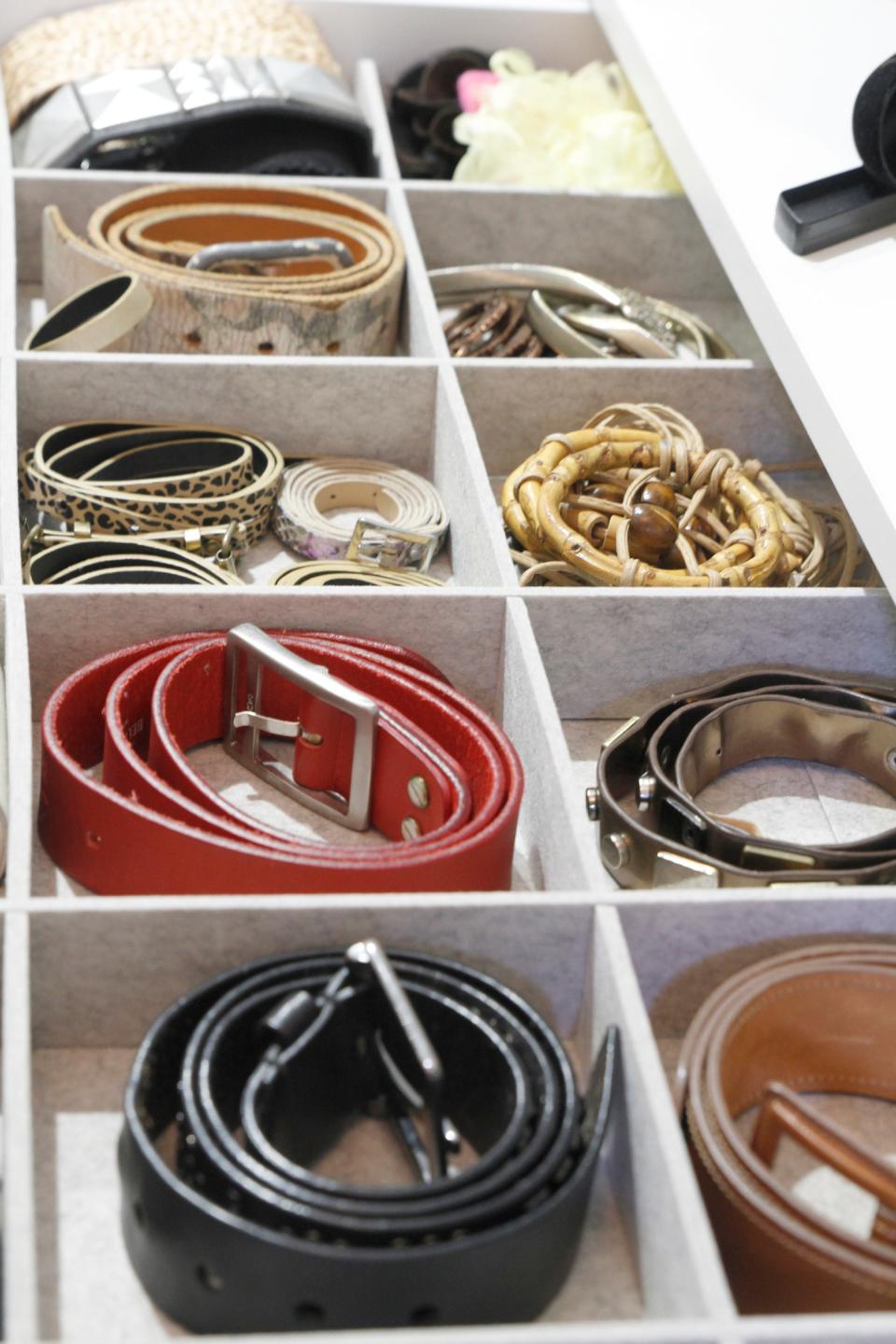
Belts Organized In Drawer
Don’t go overboard. “Bringing in products when your closet has too many items can add to the clutter and distract you from the goal of freeing up space,” warns Traub. That said, “products and bins have their place in a closet cleanout. They can help build structure and categories for your items.”
Traub is partial to matching velvet hangers. “Their sleek look and feel free up space and create an orderly appearance for clothing items,” he says.
Lightfoot says it’s simple to get organized without spending a ton of money on organizing products. For her, shelf dividers are great if you fold your T-shirts, sweaters, cardigans, jeans, or other pieces of clothing. They prevent stacks of items from falling over and landing on the floor. “We also commonly use sweater boxes with our clients, particularly if they have delicate items that will be ruined by hangers and should be folded instead,” she says.
Weiss offers a few tips when it comes to selecting and purchasing bins and containers:
Ensure all bins are a good fit for your closet
You measured your closet dimensions, right? Right. “Avoid buying bins which are too short or too shallow for your shelf, as they will leave room for clutter to build up, either on top of the bin or in front of the container,” cautions Weiss. If you buy bins and containers that don’t suit your needs, the products themselves become a source of clutter.
Use bins and containers which fit your personal style preferences
“If you’re someone who wants to see all of your items in their respective bins, I recommend using clear bins. For instance, you may want to use clear shoe boxes so you can see each pair when planning which shoes to wear with a certain outfit,” she says. “If you want to add style and pop to your closet, you can buy cloth or wicker bins, depending on whichever fit the style of your room.”
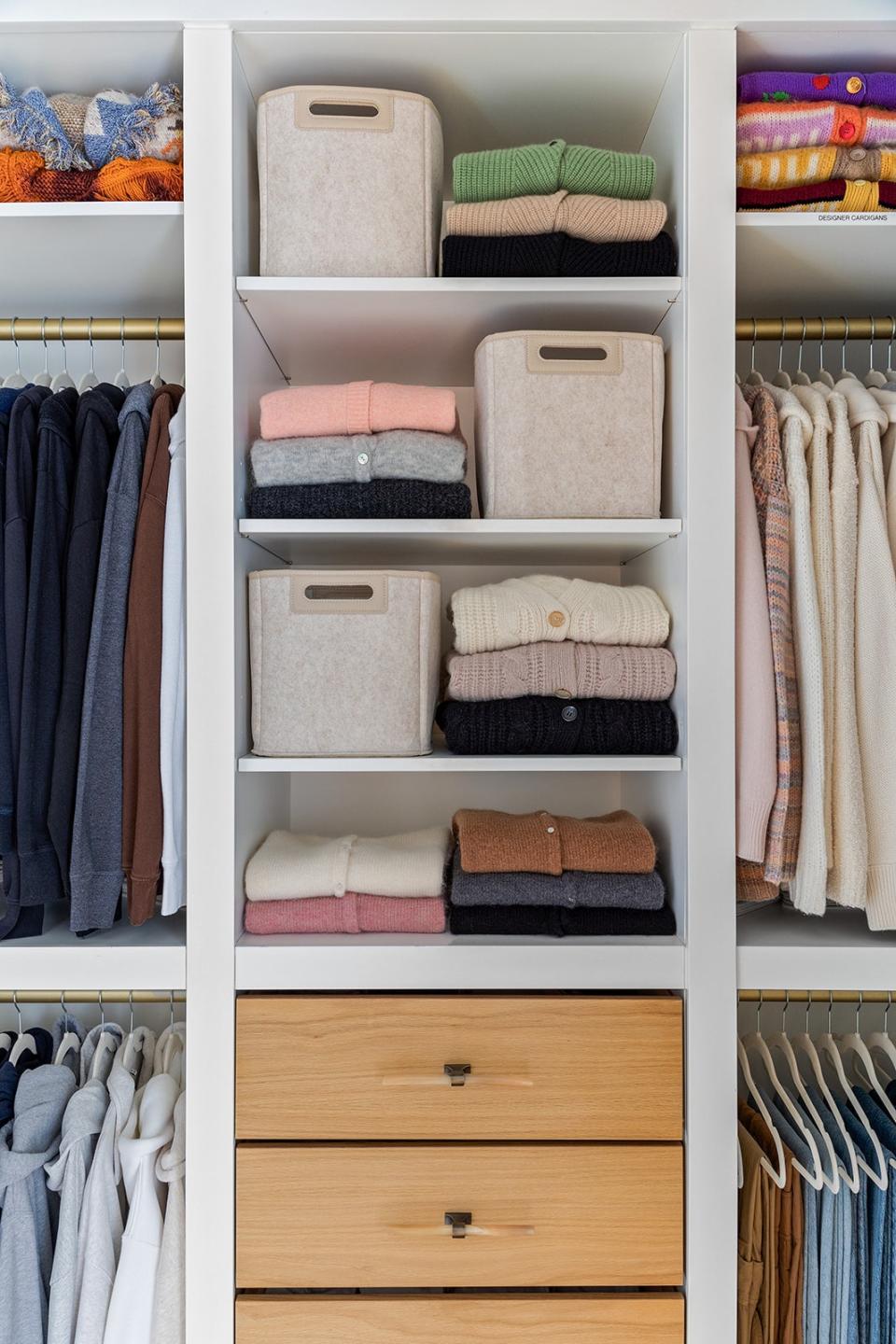
25B
Label all bins and containers
Weiss says that this creates a system to help maintain an organized closet. A Sharpie and paper taped to your organizational vessels does the trick just fine, or get extra credit for using a spiffy label-maker machine.
What organizing bins, containers, and accessories should I buy?
Here are a few of our favorite product recommendations for organizing your closet.
These lightweight bins come in three chic colorways (Stone, Carbon, Combo), so they are sure to look great in your wardrobe. We also love that each bin has a handle for easy portability.
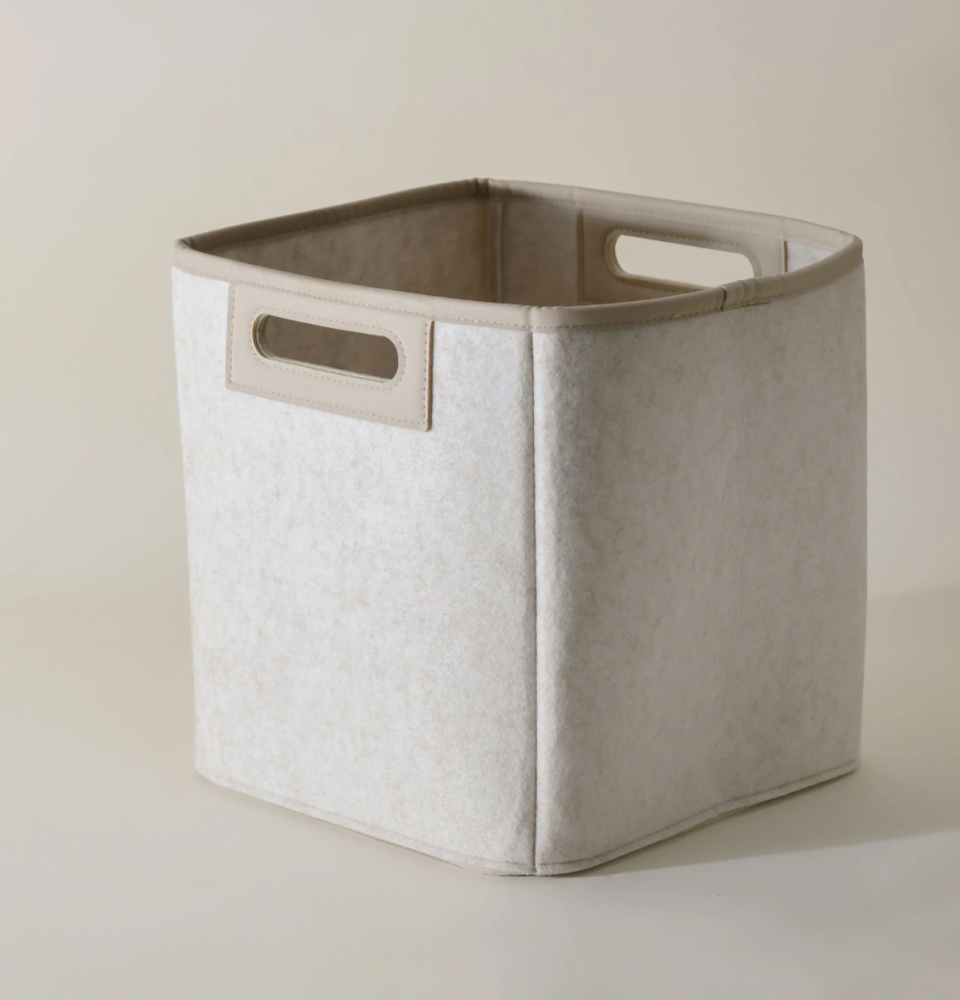
The Jamie Bin - 10"
$44.00, Sort Joy
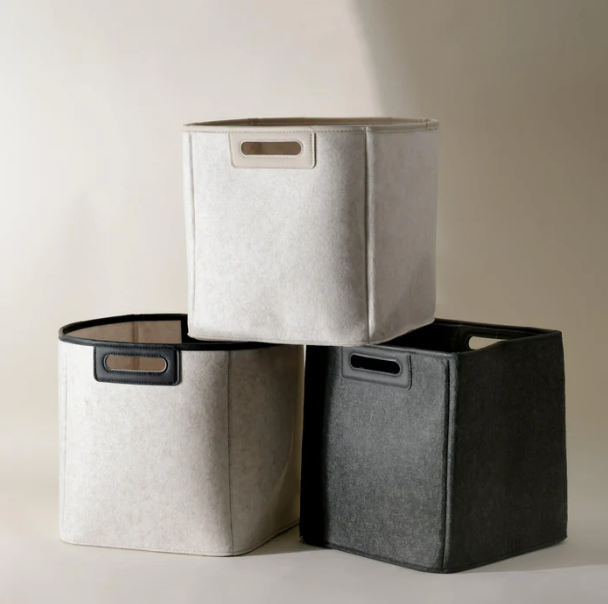
The Jamie Bin - 12"
$52.00, Sort Joy
No more closet space? No problem. The genius Temple Street Collection from the Pottery Barn is a vertical storage solution with modular capabilities. We love the space this clothing rack affords below hanging clothes for shoes, folded stacks, bags, and more.
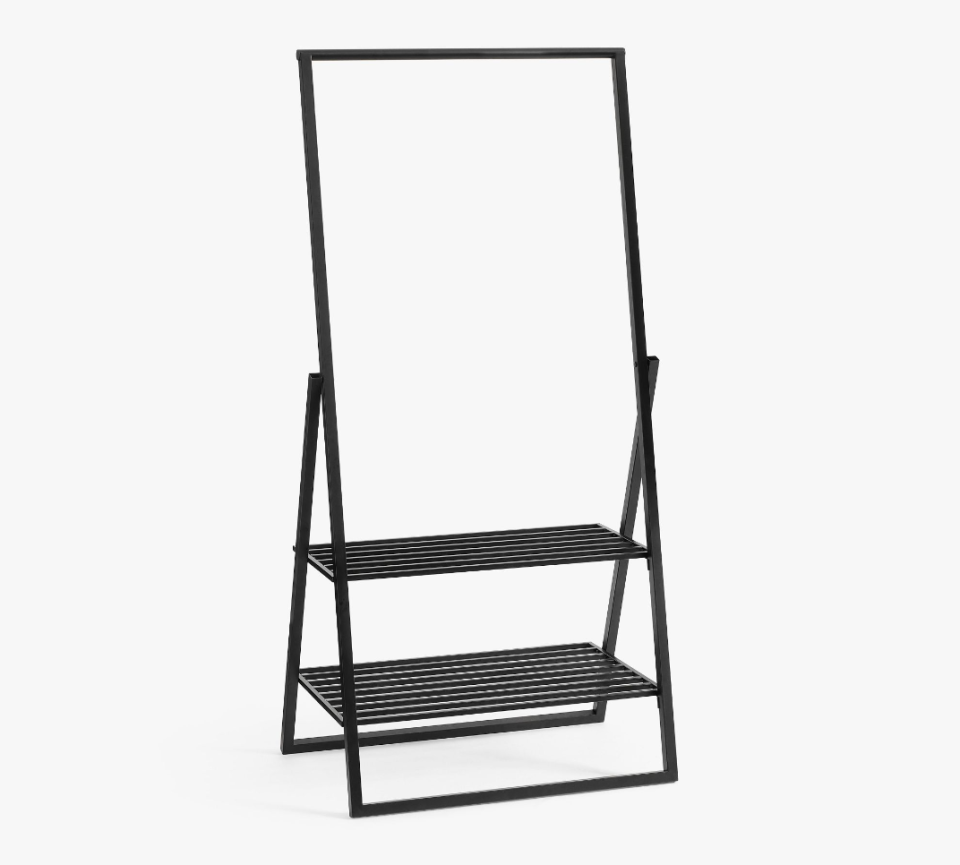
Temple Street Clothing Rack
$300.00, Pottery Barn
The organization baskets to end all baskets. These are consciously handcrafted from renewable seagrass. They add a bit of decor finesse to random nooks in your closet, pantry, or virtually anywhere in your abode (like in the laundry room or under your coffee table). The braided handles are functional and look great to boot.
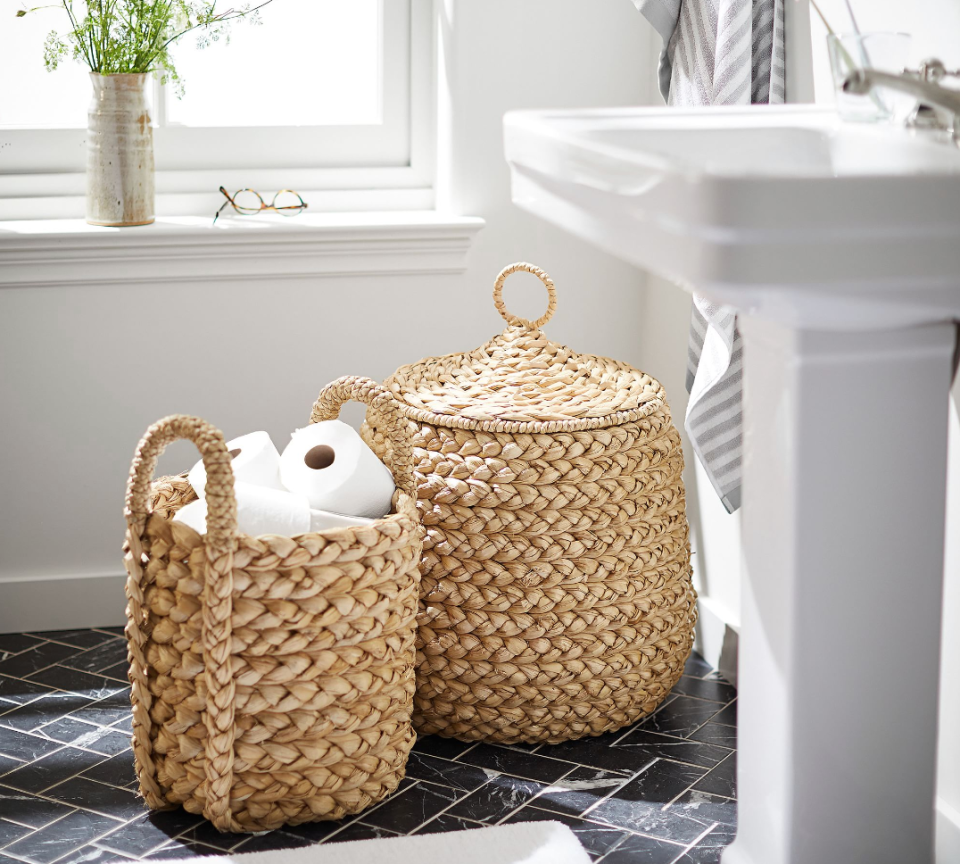
Beachcomber Handwoven Basket Collection
$174.00, Pottery Barn
Made with recycled material, this is another top pick of ours from the organizational wizards at SortJoy. With an elegant, modern silhouette, this structured piece won’t lose its shape with time and comes with a lid so you can stack them one on top of the other.
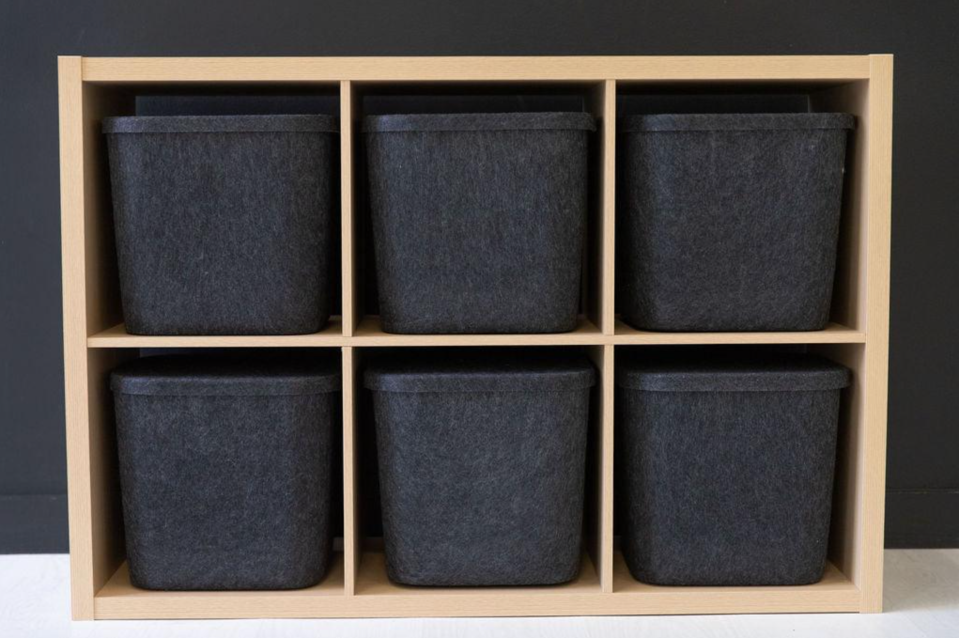
The Sculpted Bin - Original with Lid
$56.00, Sort Joy
If you’re in the market for clear storage containers, it’s hard to outshine this classic selection from the Container Store. It makes finding everything in your closet as simple as can be, and you can add an optional matching fitted large lid to keep dust away from your garments.
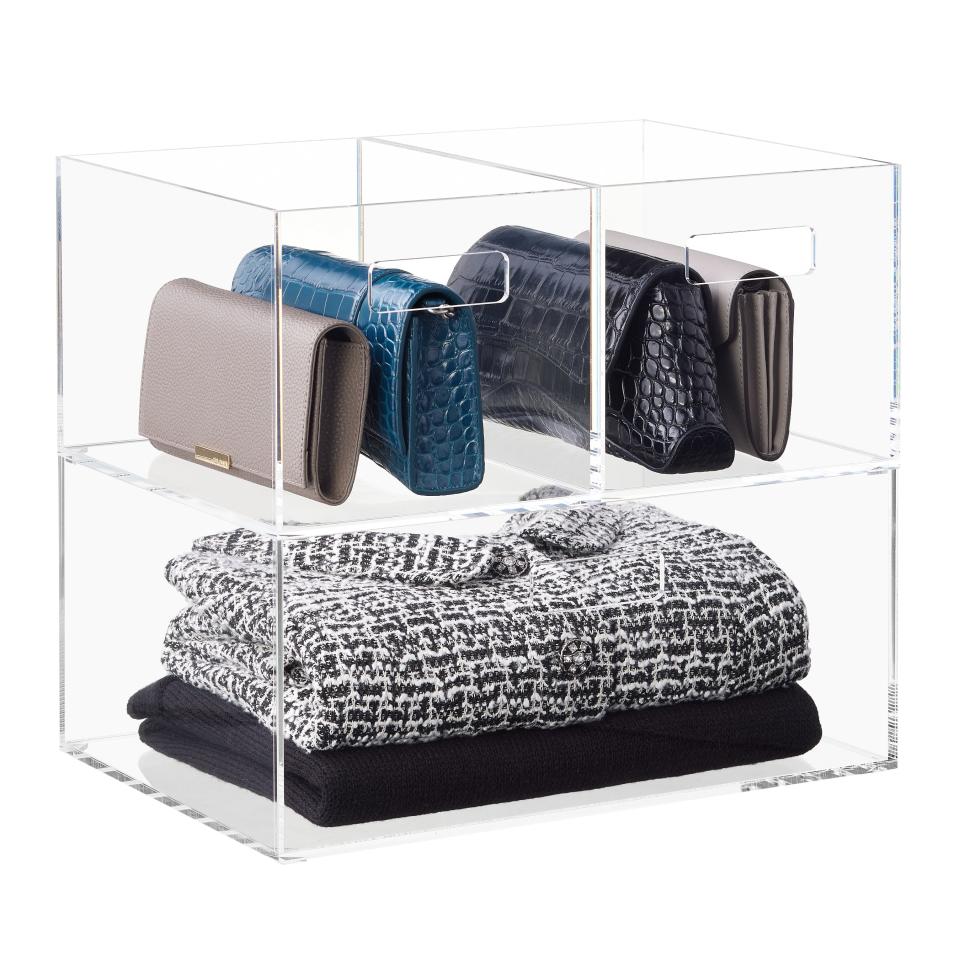
Large Luxe Acrylic Bin Clear
$50.00, The Container Store
One oft overlooked part of closet organization is keeping your shoes in order. Prevent footwear mixups with this acrylic shoe rack that lets you scan your kicks at a glance. If you have a lot of shoes and enough closet real estate, consider placing two or three side-by-side.
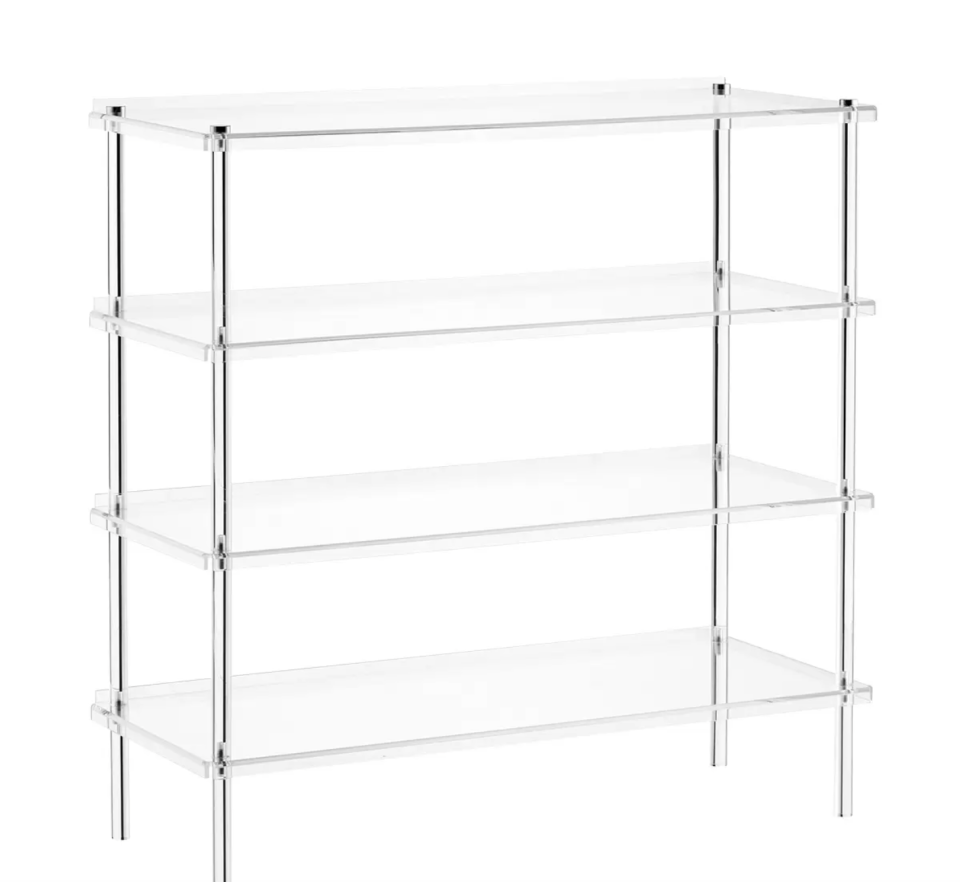
4-Tier Luxe Acrylic Shoe Rack Clear
$180.00, The Container Store
Or how about you move your shoes out of your stuffed-to-the gills closet and into the entryway? We love this solution for apartment living, which double as a bench for you to sit on and lace up your sneaks. Bonus: This piece is made at a Fair Trade Certified factory.
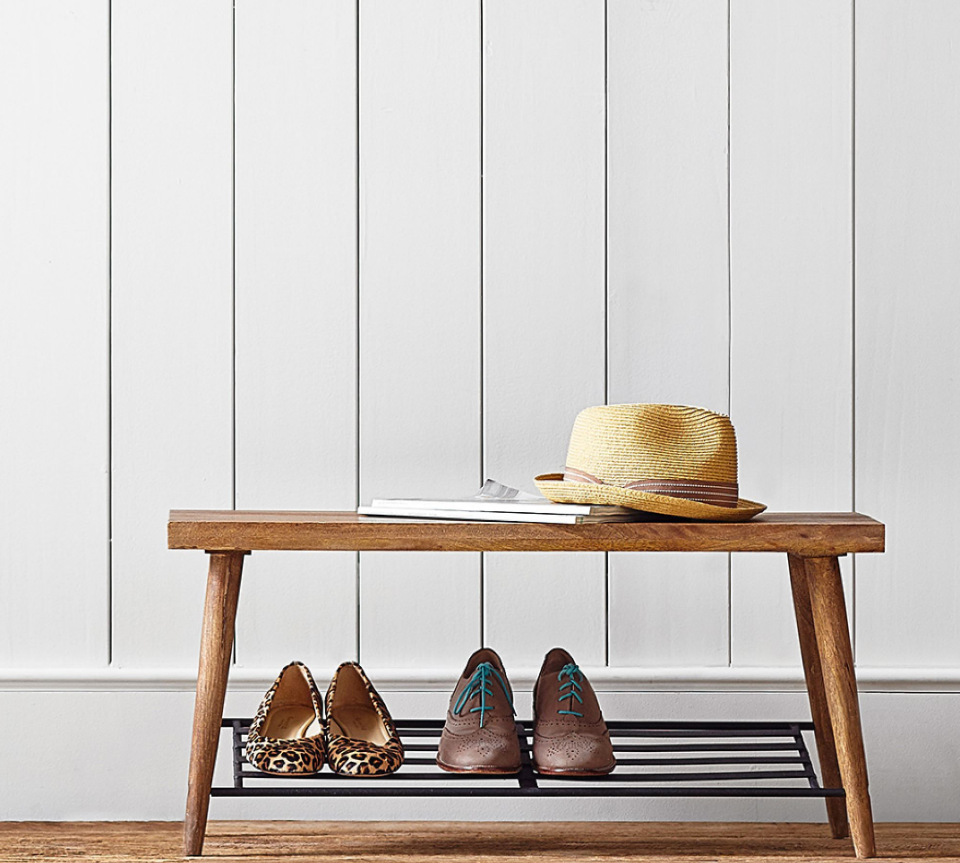
Lucy Mango Wood Shoe Rack with Bench
$200.00, Pottery Barn
Warm, honey-brown rattan makes a statement in this handwoven storage vessel. Cutout bin handles complete the look in this piece that can be used to store hats, gloves, and other small accessories.
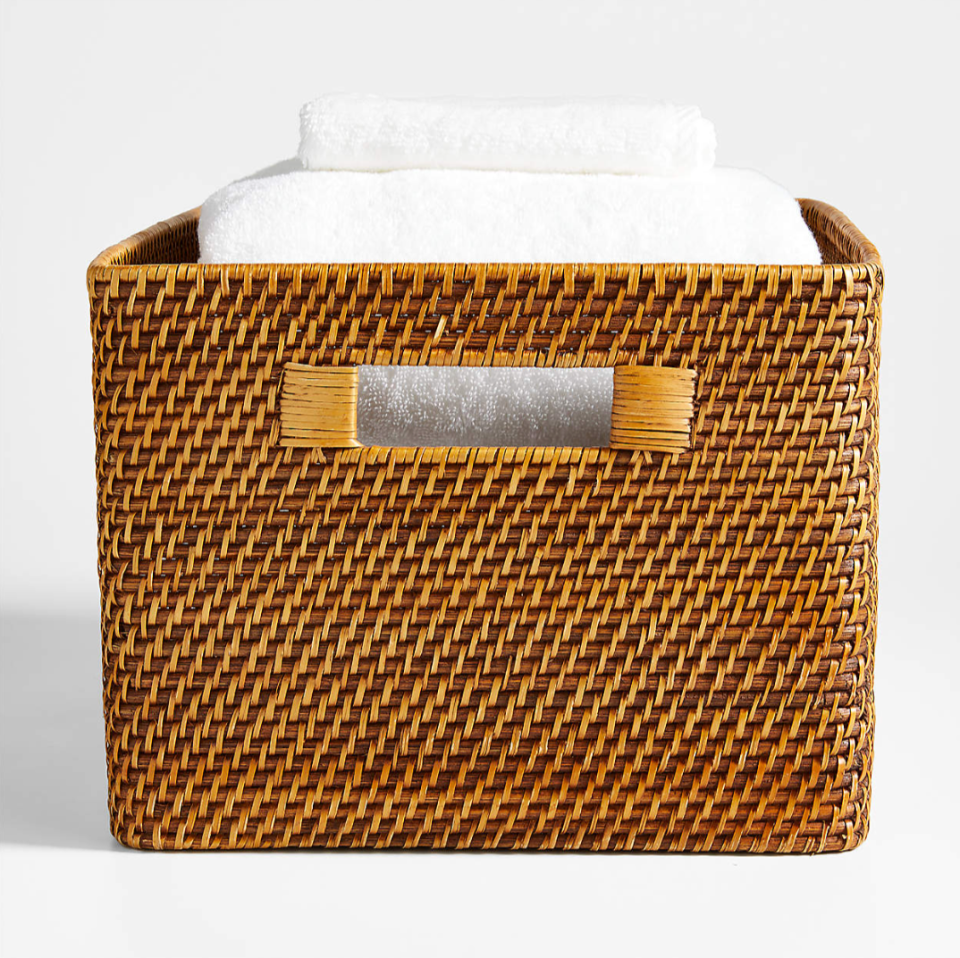
Sedona Honey Large Tote
$60.00, Crate&Barrel
You shouldn’t have to fear an avalanche of clothing every time you open your closet, so consider this compact laundry basket made of durable canvas to avert disaster. If you have more space in your wardrobe, opt for the Crate and Barrel’s Sedona White Hamper ($140), which comes in four colors.
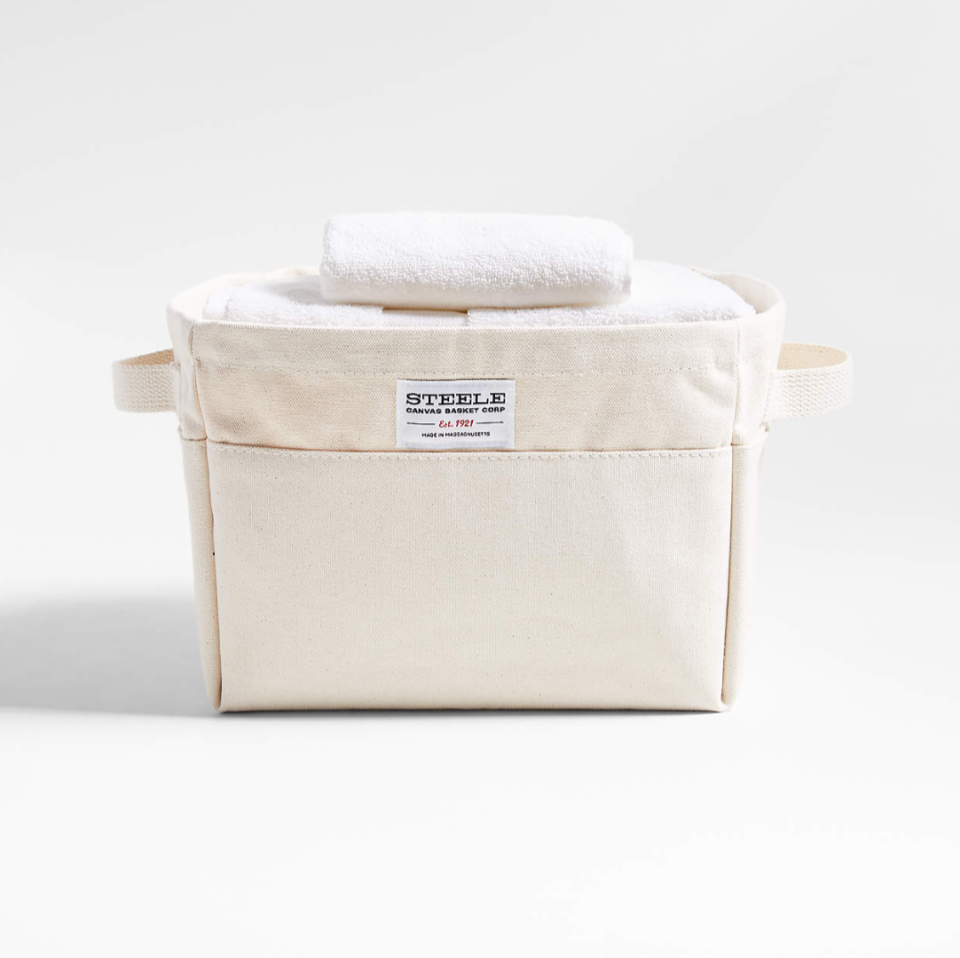
Steele ® Small Canvas Storage and Laundry Basket
$60.00, Crate&Barrel
What should I do with items I don’t want?
Weiss advises donating to charities such as the Salvation Army, Goodwill, and Green Drop. Traub especially likes to recommend clients use donation services that do routine pickups. “There are many services that will pick up your boxes of donations for you, and all you have to do is schedule a date and set them on your doorstep,” he says.
Both Traub and Lightfoot agree selling your clothes and accessories can be more trouble than it’s worth, in some instances. “It’s a time-intensive process leading to us holding onto our clutter,” Traub says. Lightfoot notes that “trying to sell things instead of donating them can quickly derail your progress” in organizing your closet. If you are still interested in reselling your clothes, Weiss recommends considering platforms such as ThredUp, Facebook Marketplace and The Real Real.
Some of your closet haul may also be able to live another life. “If you would like to repurpose some sentimental items, like old T-shirts, you can turn them into a blanket using My T-Shirt Blanket,” says Weiss.
How should I organize the items in my closet?
Lightfoot concedes that while the layout of clothing closets vary, the Done & Done Home team typically follows the same formula: “We place clothes that are in season and [your] current size front and center on shelves and hangers,” she says. “We then arrange things by category, so for example with shirts we would [organize by] sleeveless, short sleeve, long sleeve, formal, casual and work.” In some cases, they would next arrange items by color, “but we never want to make a system so specific that it becomes difficult to maintain,” she says. The key is to prioritize accessibility and visibility for everything you’re currently wearing.
For a coat closet, Weiss recommends sorting by jacket type, i.e., heavy or light. “From there, you may want to further sort each category by color,” if you really want extra credit, she says.
Overwhelmed before even beginning?
To that common sentiment, Traub recommends always starting small. “Too many of my clients have big dreams of tackling a whole space in their home as fast as possible, but it’s easy to get overwhelmed and never get to it,” he says. “The best way is to start small, whether it be one drawer, one cabinet, one type of clothing, etc. It builds momentum and positive energy around the process, which leads to success.”
Some choose to enlist the help of a professional organizer to take on this task. “Depending on your location, professional organizer prices may vary and can be pricey if you are on a tight budget,” says Weiss. “However, for those who wish to do it themselves but just need some coaching along the way, professional organizers offer virtual organizing services where they will coach you through the process of organizing your home.” Another budget-friendly option in many areas is Taskrabbit, where you can hire organizers for a closet cleaning project for an hourly rate. And if you ask nicely, a particularly meticulous friend or family member may be willing to help you with a closet cleanout, sans charge—but be sure to have plenty of snacks and beverages on hand to keep them fueled throughout the process.
The bottom line: “Just get started!” says Lightfoot. “Even small changes will make you feel better about your closet, and small victories will encourage you to keep going.”
Originally Appeared on Architectural Digest
More Great Stories From AD It Yourself
47 Kitchen Organization Ideas That Declutter Cabinets, Countertops, and More
The Cringiest DIY Trends According to TikTok’s Favorite Designers, Decorators, and DIY’ers
How to Propagate Pothos Plants at Home: A Step-by-Step Guide
Not a subscriber? Join AD for print and digital access now.
Browse the AD PRO Directory to find an AD-approved design expert for your next project.


